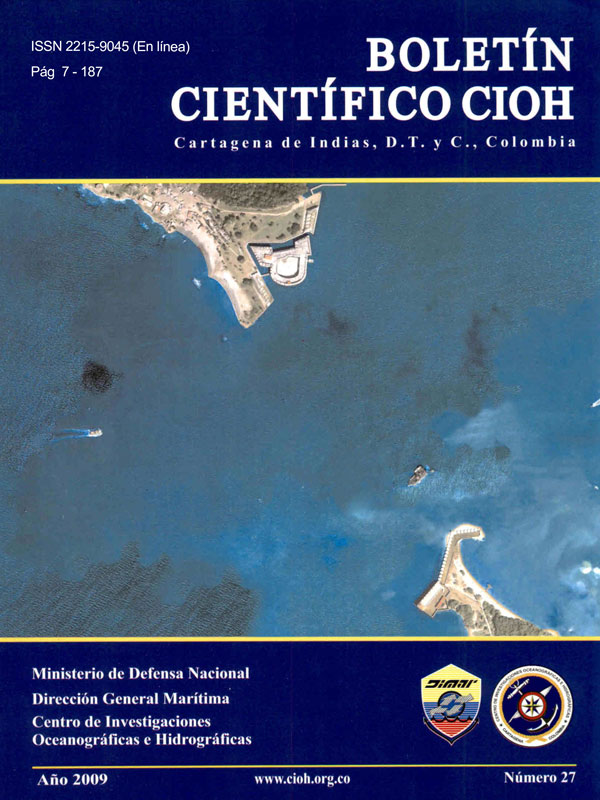Assessment of station-scale changes in climate variability under different Climate Change Scenarios. Study Case: Alberni Robertson Creek, Vancouver Island
DOI:
https://doi.org/10.26640/22159045.201Keywords:
Climate change, downscaling, neural networks, climate scenarios, Vancouver, Canada, temperatureAbstract
Simulations from the Canadian Coupled General Circulation Model version 3.1 Special Report on Emissions Scenarios A2 and A1B and the artificial neural networks (RNA) for downscaling statistically the maximum temperature and the minimum temperature daily values to the Alberni Robertson Creek weather station level, located at the Vancouver Island, Canada were used. The data generated for the station was analyzed and mean and variance were estimated; in addition, comparisons between the values for each scenario in the base period (1961-2000) and the simulations in the 21st century were carried out. The results show an increase in the values of the minimum and maximum temperature means between 1.16 and 1.47 Celsius degrees in the zone for the 21st century. The models developed accurately simulated the temperature inter-annual cycles, as well as the series mean temperature. However, the variance of the original series is greater than that of the model for the period recorded. The method employed proved to be flexible and easy to implement, with low computational requirements. Given these characteristics, using it in other regions which have reliable records for macro climatic variables is recommended.Downloads
References
[2] Wigley, T.M.L., et al. Obtaining subgrid scale information from coarse resolution general circulation model output. Journal of Geophysical Research 1990;1943-1953.
[3] Temporal neural networks for downscaling climate variability and extremes. Dibike, Y.B. y Coulibaly, P. s.l. : Elsevier, Neural Networks 2006;19:135-144.
[4] Statistical downscaling in central Europe: evaluation of methods and potential predictors. Huth, Radan. s. l. : Cimate Research, Climate Research1999; 13:91-101.
[5] Gachon, P., A. St-Hilaire, T. Ouarda, V.T.V. Nguyen, C. Lin, J. Milton, D. Chaumont, J. Goldstein, M. Hessami, T.D. A first evaluation of the strength and weaknesses of statistical downscaling methods for simulating extremes overvarious regions of eastern Canada. Sub-component. Environment Canada. Montreal, Quebec : Climate Change Action Fund (CCAF), 2005. pág. 209.
[6] The NCAR/NCEP40 year reanalysis project. Kalnay, E., y otros. Bulletin of the American Meteorological Society1996;437-71.
[7] CCCma. CCCma: Models, The Third Generation Coupled Global Climate Model (CGCM3). Canadian Centre for Climate Gaitán: Determinación de cambios en la variabilidad climática bajo diferentes escenarios Modelling and Analysis. [En línea] 27 de april de 2005. [Citado el: 01 de 05 de 2009.]http://www.cccma.bc.ec.gc.ca/models/cgcm3.shtml.
[8] DAI Team. Predictor datasets derived from the CGCM3.1 T47 and NCEP/NCAR reanalysis. 2008.
[9] Some applications of artificial intelligent systems in Hydroinformatics. Obregón-Neira, N y Fragala', F. Acapulco : s.n., 2003. Proceedings of the Workshop on Environmental Decision Support Systems. 18th International Joint Conference on Artificial Intelligence.
[10] Bayesian interpolation. MacKay, D. J. C., Neural Computation 1992; 4(3):415-447.
[11] MathWorks. Matlab: the language of technical computing, 7 edition. Massachussets : MathWorks Inc., 2004.
[12] Bishop, C.M. Neural Networks for Pattern Recognition. Oxford : Clarendon Pr., 1995.
[13] MacKay, D.J.C. Information Theory, Inference and Learning Algorithms. Cambridge : Cambridge Univ. Pr, 2003.
[14] Advantages of the mean absolute error (MAE) over the root mean square error (RMSE) in assessiong average model performance. Willmott, Cort J y Matsuura, Kenji. s.l. : Climate Research 2005; Vol. 30.
[15] IPCC; Solomon, S.; Qin, D.; Manning, M.; Chen, Z.; Marquis, M.; Averyt, K.B.; Tignor, M.; Miller, H.L. (editors). Climate Change 2007: The Physical Science Basis. Contribution of Working Group I to the Fourth Assessment Report of the Intergovernmental Panel on Climate Change. Cambridge, United Kingdom and New York : Cambridge University Press 2007. pág. 996.65Boletín Científico CIOH No. 27, ISSN 0120-0542, (2009)57-65
Downloads
Published
Issue
Section
License
Attribution — You must give appropriate credit, provide a link to the license, and indicate if changes were made. You may do so in any reasonable manner, but not in any way that suggests the licensor endorses you or your use.
NonCommercial — You may not use the material for commercial purposes.
NoDerivatives — If you remix, transform, or build upon the material, you may not distribute the modified material.
No additional restrictions — You may not apply legal terms or technological measures that legally restrict others from doing anything the license permits.



